The Electronic Intifada 21 May 2004
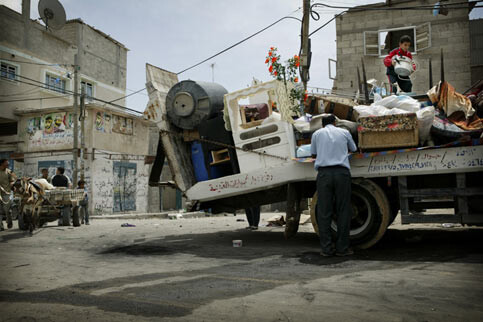
17 May 2004. Rafah residents in Block ‘O’ rush to save their belongings before an expected Israeli incursion in the refugee camp. Their fears were well founded. Writing in the Washington Post yesterday, Molly Moore noted that, since the beginning of the Second Palestinian Intifada in September 2000, “Israeli military bulldozers have crushed 1,218 houses along the northern edge of the border between Gaza and Egypt, pushing back the city of Rafah and the adjacent refugee camp. A mile-long swath of broken concrete, splintered wood and twisted metal is all that remains of what Azizah Abu Anzah and others say was a close-knit community built by families and neighbors who gathered here a half-century ago in a cluster of U.N. tents.”

18 May 2004. Palestinian women mourning in the aftermath of an Israeli attack on Rafah.
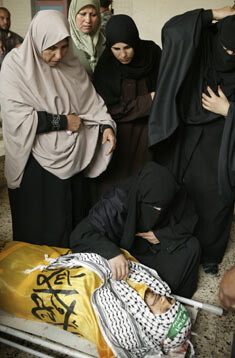
18 May 2004. A Palestinian killed by an Israeli missile near Block ‘O’ in Rafah, surrounded by mourning relatives.
“Early this morning, the Red Crescent was called to evacuate the body of a man killed in the Tel a-Sultan neighborhood. Ashraf al-Khatib, the ambulance driver, told B’Tselem that soldiers who had taken over a nearby house shot at the ambulance team as they tried to reach the body. A man assisting with the evacuation was killed.
“According to al-Khatib, the IDF has dug trenches around Tel a-Sultan, preventing ambulances from entering the neighborhood. The Red Crescent received calls to treat 15 wounded and four dead in the area shelled by the IDF, however they are unable to evacuate them.
“According to reports given to Physicians for Human Rights-Israel, at least one ambulance was hit by IDF gunfire during the night. According to a doctor that was in the ambulance, ‘at 3:00 am, we received a call that a person was injured in the Tel a-Sultan area. We went into the camp with lights flashing and our siren. We wore Red Crescent vests and did not see any soldiers as we went in. The army started shooting at us suddenly and wildly. The car was hit and we couldn’t continue. We left the ambulance and went into one of the houses.’
“Muhammad Qamise, a local radio journalist, told B’Tselem that the IDF has surrounded the Tel a-Sultan clinic and destroyed one of its walls. The IDF forbade the 18 clinic staff from leaving. According to Qamise, many residents report dead and injured who cannot be evacuated.”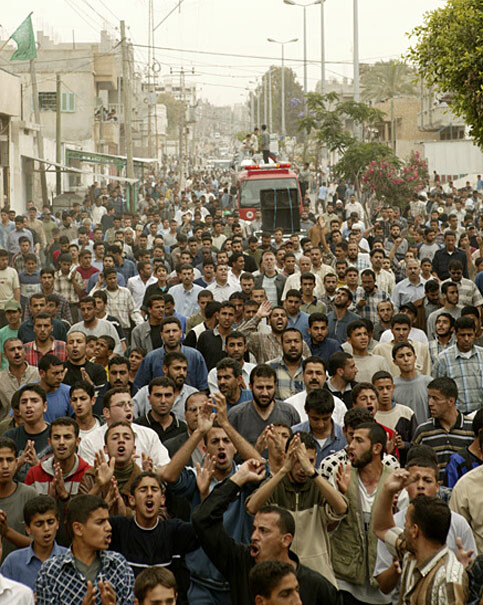
19 May 2004. Al-Mezan Center for Human Rights in Gaza reported today that since the beginning of the Israeli incursion on 18 May 2004, 99 children and 18 female teachers and workers were detained in the orphanage run by the SOS association in the Tel Al-Sultan district of Rafah. The manager of the orphanage, who lives in the premises with his family, confirmed that Israeli troops opened fire on the orphanage at several occasions. Loudspeakers were heard in Tel Al-Sultan calling all men over the age of 16 to gather in a neighborhood school. Sources in Tel Al-Sultan reported that Israeli troops fired on men who left their homes to comply with the instructions, killing 4. Above, Palestinian residents of Rafah march to Tel Al-Sultan to protest the Israeli measures. This image was taken a few minutes before Israel fired tank shells and helicopter missiles at the unarmed demonstrators.

19 May 2004. With haze from the Israeli helicopter missiles and tank shells in the background, Palestinians flee the scene of the attack carrying an injured young man towards nearby medical centers.
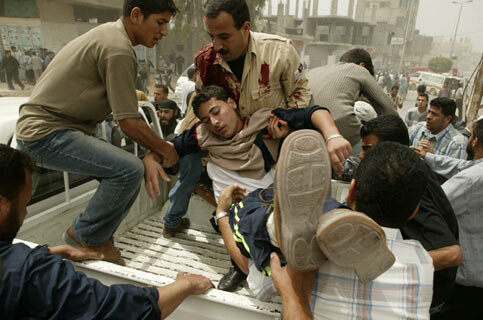
19 May 2004. Covered with blood, a man places an injured demonstrator in the back of a pickup truck.
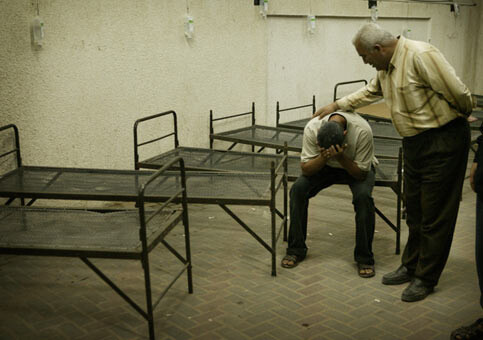
19 May 2004. A grieving relative is comforted as he weeps in Najjar Hospital.
In an affadavit to the Al-Mezan Center for Human Rights in Gaza about the 19 May 2004 attack on the demonstration, photographer Johannes Abeling stated that: “I was in the demonstration as thousands of people started to gather near the Al Awda Mosque in Rafah at around 2 pm. All the time I was in the middle of the demonstration. I noticed two armed Palestinians in the beginning of the demonstration, but saw them leave as the demonstrators marched within a few kilometers from where Israeli troops were positioned. I heard and saw no firing at the Israelis from within the demonstration. I heard flares of gunfire from Israeli troops as the mass of civilians continued to march. The first explosion I heard was a huge, and it targeted the front of the demonstration. There were numerous casualties. The Israelis fired no warning missiles near the demonstration before this. Then, I heard several explosions and saw people running everywhere. I saw what looked to be about 50 casualties (dead and wounded); many of them children. I do not understand why an army has fired missiles into a crowd of peaceful demonstrators. This was a horrible experience.”
Warning: Graphic images below

19 May 2004. Palestinian men and children killed by the Israeli attack on the demonstration lie on the floor of a makeshift morgue located in the freezer of a florist in north west Rafah.
“The Israeli shelling hit a built-up area on Sea Street, the main east-west road in Rafah, where the Palestinian demonstrators were walking. An Israeli army aerial photograph published in the Israeli media shows that the building at which the tank shelling was aimed is located in a built-up area on the street where the demonstrators were marching. Israeli officials have alleged that the demonstrators were led by gunmen.
“While Amnesty International cannot confirm or deny the presence of armed Palestinians among the demonstrators, the organization’s delegates did not see any armed men when they passed the demonstration prior to the attack. In addition, they did not hear any Palestinian fire prior to or following the Israeli army shelling. Furthermore, the footage from television crews who filmed the demonstration prior to, during and after the shelling, reviewed by Amnesty International’s delegates, does not show armed individuals in the demonstration.”
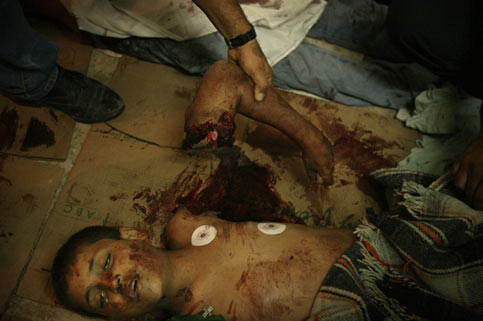
19 May 2004. A child killed by the Israeli missile attack lies on the floor of a makeshift morgue.
Related Links
